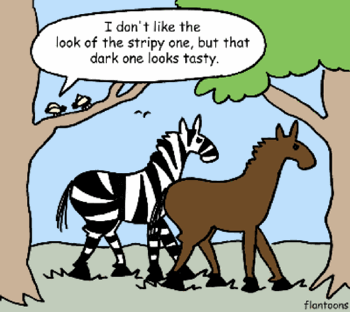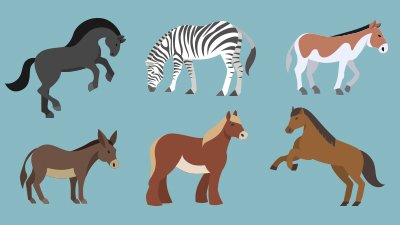How the Zebra Got its Stripes
So, how did the zebra get its stripes?
News Source
Move over, Rudyard Kipling. Here’s a “Just So Story” extrapolating from Hungarian horseflies and plastic zebras to the evolutionary past of zebras on the African savannah. Yet for all its limitations (most of all, it does not demonstrate any evidence for molecules-to-man evolution), the study just published in the Journal of Experimental Biology is the first experimental evidence actually documenting a potential selective advantage to having stripes.
Hungarian and Swedish researchers observed Hungarian horseflies bothered dark horses worse than white ones and set out to learn why.1 Horseflies—of which there are 41542 pesky species worldwide—use their mandibles to tear flesh, driving some animals to distraction while extracting blood and often transmitting blood-borne infections to their victims.3 The team noted light bouncing off dark horses was polarized, whereas light reflected from white coats scattered. Light reflected off water is polarized, with the light waves aligned. Knowing horseflies lay eggs in water, the researchers suggested polarized light attracts horseflies for this reason.

Cartoon from the peer-reviewed Journal of Experimental Biology4 summing up the latest research. Apparently creation scientists aren’t the only ones who like to use cartoons to get their points across.
Having confirmed experimentally that horseflies were attracted to polarized light, the team set out to discover the zebra’s secret. Zebra embryos start out black and acquire white stripes by prevention of melanin deposition in species-specific patterns. After luring horseflies to a sticky demise on a several surfaces at a horsefly-infested Hungarian horse farm, the team discovered horseflies were actually repelled by stripes even more than by plain white. The narrower the stripes, the more repulsive.
“We created an experimental set-up where we painted the different patterns onto boards,” said Dr. Susanne Akesson. “We put insect glue on the boards and counted the number of flies that each one attracted.” The most realistic zebra pattern attracted the fewest horseflies, “even less than the white boards that were reflecting unpolarised light,” she explained. “That was a surprise because, in a striped pattern, you still have these dark areas that are reflecting horizontally polarised light. But the narrower (and more zebra-like) the stripes, the less attractive they were to the flies.”
Since zebras are notably absent from Hungary, the final field experiments involved life-size plastic horses sporting brown, black, white, and realistic zebra-patterned “flypaper” (actually, a coating of insect-monitoring glue). The plastic ponies confirmed the findings in the sun and in the shade.
The team suggests biting horseflies distracted ancestral horses from grazing efficiently, thus hampering reproductive fitness and survival of stripe-less creatures.
The shunned stripe widths are actually those present on the head and legs of the three living zebra species, leaving zebra backs unprotected. The team writes that thin skin doesn’t protect blood vessels well on the head and legs, making them more vulnerable to irritation. They write, “In the head, there are several sensory organs (eyes, ears, tongue, muzzle), the efficient functioning of which is most important for survival. The legs also are indispensable to escape from predators. Consequently, head and legs must be protected in the best possible way from blood-sucking parasites . . . since any injury to these body parts due to aggressive biting insects might result in their insufficient functioning, undermining the escape and survival of the animal.” The team suggests biting horseflies distracted ancestral horses from grazing efficiently, thus hampering reproductive fitness and survival of stripe-less creatures.
While the researchers don’t claim horseflies were the only selective pressure giving zebras an evolutionary advantage in Africa, they point out that none of the other ideas explaining zebra evolution—camouflage, visual confusion of predators, social recognition, mate attraction, and thermoregulation—have any experimental data to support them. Darwin maintained the ancestral horse was striped,5 so from an evolutionary point of view, according to University of Manchester’s Matthew Cobb, the researchers need to “show that tabanid [horsefly] fly bites are a major selection pressure on zebras, but not on horses and donkeys found elsewhere in the world . . . none of which are stripy.”
Biblically and scientifically, we know zebras, horses, ponies, and donkeys are of the same created kind. God created animals to reproduce “after their kinds.” The fact all these animals are able to mate and produce hybrid offspring that are fun to see and name—zonkeys, zorses, zebrulas, hebras, and mules—confirms they are of the same kind. Answers in Genesis molecular geneticist Dr. Georgia Purdom agrees, “A pair of the equine kind got off Noah’s ark about 4,300 years ago, and genetic information—including genes for various coat colors—in that pair provided the raw material for all the equine varieties we see today. Speciation mediated through natural selection and other means enabled their descendants to adapt to many environments in the post-Flood world.” There is certainly no “hydrocarbon-to-horse” evolution evidenced in this study, just one possible means by which annoying insects could have been a factor in the speciation of horses.
Further Reading
For More Information: Get Answers
Remember, if you see a news story that might merit some attention, let us know about it! (Note: if the story originates from the Associated Press, FOX News, MSNBC, the New York Times, or another major national media outlet, we will most likely have already heard about it.) And thanks to all of our readers who have submitted great news tips to us. If you didn’t catch all the latest News to Know, why not take a look to see what you’ve missed?
(Please note that links will take you directly to the source. Answers in Genesis is not responsible for content on the websites to which we refer. For more information, please see our Privacy Policy.)
Footnotes
- Victoria Gill, “Zebra Stripes Evolved to Keep Biting Flies at Bay,” BBC, February 9, 2012, http://www.bbc.co.uk/nature/16944753.
- Ádám Egri et al., “Polarotactic Tabanids Find Striped Patterns with Brightness And/Or Polarization Modulation Least Attractive: an Advantage of Zebra Stripes,” Journal of Experimental Biology 215 (2012): 736–745, doi:10.1242/jeb.065540
- Ed Yong, “White Horses Are Less Attractive to Horseflies: Not Exactly Rocket Science,” February 3, 2010, http://blogs.discovermagazine.com/notrocketscience/2010/02/03/white-horses-are-less-attractive-to-horseflies/.
- Kathryn Knight, “How the Zebra Got Its Stripes,” Journal of Experimental Biology (2012): doi:10.1242/jeb.070680.
- Jerry Coyne, “Why Do Zebras Have Stripes?,” Why Evolution Is True, February 10, 2012, https://whyevolutionistrue.wordpress.com/2012/02/10/why-do-zebras-have-stripes/.

Answers in Genesis is an apologetics ministry, dedicated to helping Christians defend their faith and proclaim the good news of Jesus Christ.
- Customer Service 800.778.3390
- Available Monday–Friday | 9 AM–5 PM ET
- © 2025 Answers in Genesis




